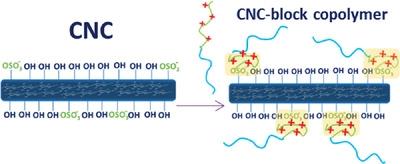当前位置:
X-MOL 学术
›
Macromol. React. Eng.
›
论文详情
Our official English website, www.x-mol.net, welcomes your
feedback! (Note: you will need to create a separate account there.)
Non-Covalent Polymer Surface Modification of Cellulose Nanocrystals Using Block Copolymers
Macromolecular Reaction Engineering ( IF 1.8 ) Pub Date : 2021-12-14 , DOI: 10.1002/mren.202100046 Olga Lidia Torres‐Rocha 1 , Sophie Campbell 1 , Nicole Woodcock 2 , Julien Pinaud 3 , Patrick Lacroix‐Desmazes 3 , Pascale Champagne 1, 2 , Michael F. Cunningham 1
Macromolecular Reaction Engineering ( IF 1.8 ) Pub Date : 2021-12-14 , DOI: 10.1002/mren.202100046 Olga Lidia Torres‐Rocha 1 , Sophie Campbell 1 , Nicole Woodcock 2 , Julien Pinaud 3 , Patrick Lacroix‐Desmazes 3 , Pascale Champagne 1, 2 , Michael F. Cunningham 1
Affiliation

|
Cellulose nanocrystals (CNC) possess desirable mechanical and optical properties that make them a candidate in the development of the next generation of polymer-based composites. However, CNC also have a critical issue associated with their use: their hydrophilicity and incompatibility with hydrophobic polymers. CNC surface properties must be modified for them to be successfully implemented by the industrial sector. Grafting (co)polymers chains on the CNC surface can provide compatibility to CNC with hydrophobic matrices and expand their potential range of applications. In this communication preliminary results of a simple method to functionalize CNC surface are reported using block copolymers, where a cationic block anchors via complexation to the anionically charged CNC surface and the other block acts as a stabilizing block, providing dispersibility in various solvents. This is a much simpler and less expensive method than current routes based on covalent modification. The block copolymers poly(polyethylene glycol methacrylate)-b-poly(N-butyl-N′-vinyl imidazolium bromide) (PPEGMA-b-PBuVIm) and poly(styrene)-b-PBuVIm (PS-b-PBuVIm) are first synthesized via nitroxide-mediated polymerization and then non-covalently adsorbed on the CNC surface. The functionalization has been confirmed via FT-IR and TGA. The dispersion of polymer-modified CNC materials in organic solvents is evaluated via dynamic light scattering. Modified CNC yielded stable dispersions in organic solvents.
中文翻译:

使用嵌段共聚物对纤维素纳米晶体进行非共价聚合物表面改性
纤维素纳米晶体 (CNC) 具有理想的机械和光学性能,使其成为开发下一代聚合物基复合材料的候选材料。然而,CNC 也有一个与其使用相关的关键问题:它们的亲水性和与疏水性聚合物的不相容性。必须修改 CNC 表面特性,才能在工业部门成功实施。在 CNC 表面接枝(共)聚合物链可以使 CNC 与疏水性基质相容,并扩大其潜在的应用范围。在本次交流中,使用嵌段共聚物报告了一种简单的 CNC 表面功能化方法的初步结果,其中一个阳离子嵌段通过络合与带阴离子电荷的 CNC 表面结合而锚定,另一个嵌段充当稳定嵌段,提供在各种溶剂中的分散性。与基于共价修饰的当前路线相比,这是一种更简单且更便宜的方法。嵌段共聚物聚(聚乙二醇甲基丙烯酸酯)-b-聚(N-丁基-N'-乙烯基咪唑溴化物) (PPEGMA -b- PBuVIm) 和聚(苯乙烯) -b- PBuVIm (PS -b- PBuVIm) 首先通过硝基氧介导的聚合反应合成,然后非- 共价吸附在 CNC 表面。功能化已通过 FT-IR 和 TGA 确认。通过动态光散射评估聚合物改性 CNC 材料在有机溶剂中的分散性。改进的 CNC 在有机溶剂中产生稳定的分散体。
更新日期:2021-12-14
中文翻译:

使用嵌段共聚物对纤维素纳米晶体进行非共价聚合物表面改性
纤维素纳米晶体 (CNC) 具有理想的机械和光学性能,使其成为开发下一代聚合物基复合材料的候选材料。然而,CNC 也有一个与其使用相关的关键问题:它们的亲水性和与疏水性聚合物的不相容性。必须修改 CNC 表面特性,才能在工业部门成功实施。在 CNC 表面接枝(共)聚合物链可以使 CNC 与疏水性基质相容,并扩大其潜在的应用范围。在本次交流中,使用嵌段共聚物报告了一种简单的 CNC 表面功能化方法的初步结果,其中一个阳离子嵌段通过络合与带阴离子电荷的 CNC 表面结合而锚定,另一个嵌段充当稳定嵌段,提供在各种溶剂中的分散性。与基于共价修饰的当前路线相比,这是一种更简单且更便宜的方法。嵌段共聚物聚(聚乙二醇甲基丙烯酸酯)-b-聚(N-丁基-N'-乙烯基咪唑溴化物) (PPEGMA -b- PBuVIm) 和聚(苯乙烯) -b- PBuVIm (PS -b- PBuVIm) 首先通过硝基氧介导的聚合反应合成,然后非- 共价吸附在 CNC 表面。功能化已通过 FT-IR 和 TGA 确认。通过动态光散射评估聚合物改性 CNC 材料在有机溶剂中的分散性。改进的 CNC 在有机溶剂中产生稳定的分散体。











































 京公网安备 11010802027423号
京公网安备 11010802027423号